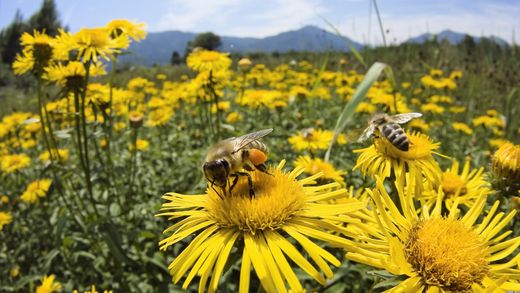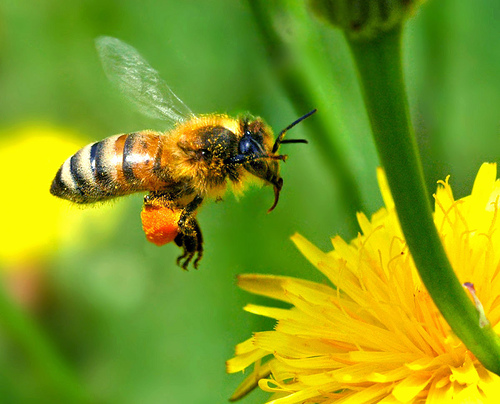Earth Watch Report - Biological Hazards
© Unknown
....
Bees dying by the millions in Elmwood, ON, Canada
Jon Radjkovic
thepost.on.ca
Wed, 19 Jun 2013 15:16 CDT
thepost.on.ca
Wed, 19 Jun 2013 15:16 CDT
Via Sott.net
"Once the corn started to get planted our bees died by the millions," Schuit said. He and many others, including the European Union, are pointing the finger at a class of insecticides known as neonicotinoids, manufactured by Bayer CropScience Inc. used in planting corn and some other crops. The European Union just recently voted to ban these insecticides for two years, beginning December 1, 2013, to be able to study how it relates to the large bee kill they are experiencing there also.
Local grower Nathan Carey from the Neustadt, and National Farmers Union Local 344 member, says he noticed this spring the lack of bees and bumblebees on his farm. He believes that there is a strong connection between the insecticide use and the death of pollinators.
"I feel like we all have something at stake with this issue," he said. He is organizing a public workshop and panel discussion about this problem at his farm June 22 at 10 a.m. He hopes that all interested parties can get together and talk about the reason bees, the prime pollinators of so any different plant species, are dying.
At the farm of Gary Kenny, south west of Hanover, eight of the 10 hives he kept for a beekeeper out of Kincardine, died this spring just after corn was planted in neighbouring fields.
What seems to be deadly to bees is that the neonicotinoid pesticides are coating corn seed and with the use of new air seeders, are blowing the pesticide dust into the air when planted. The death of millions of pollinators was looked at by American Purdue University. They found that, "Bees exhibited neurotoxic symptoms, analysis of dead bees revealed traces of thiamethoxam/clothianidin in each case. Seed treatments of field crops (primarily corn) are the only major source of these compounds.
Local investigations near Guelph, led to the same conclusion. A Pest Management Regulatory Agency investigation confirmed that corn seeds treated with clothianidin or thiamethoxam "contributed to the majority of the bee mortalities" last spring.
"The air seeders are the problem," said Ontario Federation of Agriculture director Paul Wettlaufer, who farms near Neustadt. This was after this reporter called John Gillespie, OFA Bruce County president, who told me to call Wettlaufer. Unfortunately, Wettlaufer said it was, "not a local OFA issue," and that it was an issue for the Grain Farmers of Ontario and representative, Hennry Vanakum should be notified. Vanakum could not be rached for comment.
Yet Guelph University entomologist Peter Kevan, disagreed with the EU ban.
....
Neonicotinoids Destroy 600 Hives, 37 Million Bees in Canada
 A
bee here or a hive there may be chalked up to chance of a landscaping
company with heavy-handed pesticide applications, like the case where an
estimated 25,000 bees were killed
in a small Oregon town. But when millions of bees are dying at once, in
locales across Canada, there may be something more serious afoot. One
thing these casualties have in common—recent corn plantings and the related insecticides.
A
bee here or a hive there may be chalked up to chance of a landscaping
company with heavy-handed pesticide applications, like the case where an
estimated 25,000 bees were killed
in a small Oregon town. But when millions of bees are dying at once, in
locales across Canada, there may be something more serious afoot. One
thing these casualties have in common—recent corn plantings and the related insecticides.According to The Ontario Post, one local Elmwood beekeeper lost 600 hives, a total of 37 million bees following nearby corn planting. He and others believe the culprit may be a class of insecticides, neonicotinoids, made by Bayer CropScience Inc. A smaller operation in nearby Hanover was similarly wiped out this spring when neighboring farmers began planting corn.
“Once the corn started to get planted our bees died by the millions,” Dave Schuit said, the beekeeper who experienced the loss of 600 hives and 37 million bees. “I feel like we all have something at stake with this issue.”Neonicotinoids were recently banned by the European Union for two years (a period starting Dec. 1, 2013) so that they can study how they are related to the dying bees in Europe. They are completely legal in both the U.S. and Canada, however.
The pesticides coat the corn seed. New air-seeders launch the seeds for planting while the pesticide dust is blown into the air. These tiny particles make their way to nearby honey operations and the bee population at large.
Purdue University looked closely at the mass casualties of U.S. bees and found, “Bees exhibited neurotoxic symptoms, analysis of dead bees revealed traces of thiamethoxam/clothianidin in each case. Seed treatments of field crops (primarily corn) are the only major source of these compounds.”
Sort of like injecting beef cattle with antibiotics “just in case”, farmers are using seeds covered with insecticides. This so-called preventative use does more harm than good in both cases.
Read More Here
....
2012 The Awakening
Again and again: 37 million bees found dead
Shortly after 50,000 bees were found dead in an Oregon parking lot (read more here), a staggering 37 million bees have been found dead in Elmwood, Ontario, Canada. Dave Schuit, who runs a honey operation in Elmwood has lost 600 hives. He is pointing the finger at the insecticides known as neonicotinoids, which are manufactured by Bayer CropScience Inc. This also comes after a recent report released by the British Beekeepers Association (BBKA) that recorded its largest loss of honeybees ever. You can read more about that here. The European Union has stepped forward, having banned multiple pesticides that have been linked to killing millions of bees. You can view the studies and read more about that here.
The loss comes after the planting of corn. Neonicotinoid pesticides are used to coat corn seed with air seeders. This results in having the pesticide dust blown into the air when planted. The death of millions of pollinators was studied by Purdue University. They discovered that Bees exhibited neurotoxic symptoms. They analyzed dead bees and found that traces of thiamethoxam/clothiandin were present in each case. The only major source of these compounds are seed treatments of field crops. You can view that study here (1).
Read More Here
....
Save the Bees!
Read More Here
Scientists theorize that Colony Collapse Disorder may cause the next big extinction. This is because honeybees pollinate and pollination is an essential part of a stable ecosystem. Bees fly from stamen to stamen to collect pollen, to then spread to neighboring plants that can then accept the pollen, which allows the plants egg to develop into a source of food or shelter. This life cycle is vital for not just humans, but for all living organisms. To have a healthy terrestrial ecosystem, the plant, soil, and atmosphere must have beneficial or at least commensalistic interactions. In a community with CCD infected honeybees, there can be significant loss of plant life. For example, detritivores exist within a community to decompose dead material and this decomposition resupplies the soil with nutrients. If after a generation or two of lower honeybee populations, there would be less pollinated flowers, thus less fruit. In a local population sense, this would mean there would be a lower amount of fruits to decompose by the detritivores, which overall means there are fewer nutrients returned to the soil. That is just one simple example, but to imagine a whole country without pollinating bees would impact many other factors nationwide, such as photosynthetic levels. This is due to fewer seed set and plant growth, thus less carbon dioxide being converted into oxygen and organic compounds. In the big scheme of things, this would affect the atmosphere and the soil. It is hard to believe that every single thing in this world is connected, but these are just two examples that show that even a honeybee can affect the terrestrial environment.
If honeybee populations continue to fall this could potentially cost billions of dollars in the agriculture industry. Honeybees have estimated value of about $15 billion dollars in the United States, and over $215 billion dollars worldwide. It is estimated that one-third of the food eaten by U.S. citizens is thanks to honeybee pollination, either directly or indirectly. Not to mention that honeybee pollination plays an important role in pollination of other plants that are vital to maintaining an ecological balance (VanEngelsdorg 2009).
Since 2006 scientists have been trying to find some explanation for the disappearance of honeybees, but even after 6 years the data has come out inconclusive. There are many suspected causes for CCD, such as malnutrition, pathogens, immunodeficiency, pesticides, and genetically modified crops. Most researchers agree that while the exact cause of CCD remains unknown, it must be multiple factors working together that are causing the most serious die-off of honeybees ever reported. Albert Einstein once said, “If the bee disappears from the surface of the earth, man would have no more than four years to live. No more bees, no more pollination … no more men!” Nationwide there is an urgent plea for more funding and research to sustain the honeybee populations and now it rests in scientists hands to save the earth from possibly the next big extinction.
....















No comments:
Post a Comment
Hello and thank you for visiting my blog. Please share your thoughts and leave a comment :)